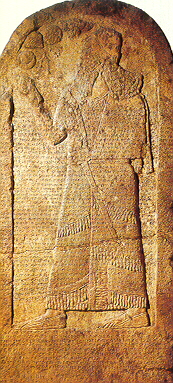Kurkh Monoliths
The Kurkh Monoliths are two Assyrian stelae that contain a description of the reigns of Ashurnasirpal II and his son Shalmaneser III.
Overview
The Monoliths were discovered in 1861 by a British archaeologist John George Taylor, who was the British Consul-General stationed in the Ottoman Eyalet of Kurdistan, in a town called Kurkh, which is now known as Üçtepe, in the district of Bismil, in the province of Diyarbakir of Turkey. Both stelae were donated by Taylor to the British Museum in 1863.
The Shalmaneser III monolith contains a description of the Battle of Qarqar at the end. This description contains the name "A-ha-ab-bu Sir-ila-a-a" which is generally accepted to be a reference to Ahab king of Israel. It is also one of four known contemporary inscriptions containing the name of Israel, the others being the Merneptah Stele, the Mesha Stele, and the Tel Dan Stele.
According to the inscription Ahab committed a force of 2,000 chariots and 10,000 foot soldiers to the Assyrian war coalition.
